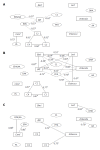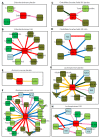Gut microbiota and host metabolism in liver cirrhosis
- PMID: 26556989
- PMCID: PMC4631963
- DOI: 10.3748/wjg.v21.i41.11597
Gut microbiota and host metabolism in liver cirrhosis
Abstract
The gut microbiota has the capacity to produce a diverse range of compounds that play a major role in regulating the activity of distal organs and the liver is strategically positioned downstream of the gut. Gut microbiota linked compounds such as short chain fatty acids, bile acids, choline metabolites, indole derivatives, vitamins, polyamines, lipids, neurotransmitters and neuroactive compounds, and hypothalamic-pituitary-adrenal axis hormones have many biological functions. This review focuses on the gut microbiota and host metabolism in liver cirrhosis. Dysbiosis in liver cirrhosis causes serious complications, such as bacteremia and hepatic encephalopathy, accompanied by small intestinal bacterial overgrowth and increased intestinal permeability. Gut dysbiosis in cirrhosis and intervention with probiotics and synbiotics in a clinical setting is reviewed and evaluated. Recent studies have revealed the relationship between gut microbiota and host metabolism in chronic metabolic liver disease, especially, non-alcoholic fatty liver disease, alcoholic liver disease, and with the gut microbiota metabolic interactions in dysbiosis related metabolic diseases such as diabetes and obesity. Recently, our understanding of the relationship between the gut and liver and how this regulates systemic metabolic changes in liver cirrhosis has increased. The serum lipid levels of phospholipids, free fatty acids, polyunsaturated fatty acids, especially, eicosapentaenoic acid, arachidonic acid, and docosahexaenoic acid have significant correlations with specific fecal flora in liver cirrhosis. Many clinical and experimental reports support the relationship between fatty acid metabolism and gut-microbiota. Various blood metabolome such as cytokines, amino acids, and vitamins are correlated with gut microbiota in probiotics-treated liver cirrhosis patients. The future evaluation of the gut-microbiota-liver metabolic network and the intervention of these relationships using probiotics, synbiotics, and prebiotics, with sufficient nutrition could aid the development of treatments and prevention for liver cirrhosis patients.
Keywords: Fatty acids; Liver cirrhosis; Metabolism; Microbiota; Probiotics.
Figures


Similar articles
-
Gut-liver axis and probiotics: their role in non-alcoholic fatty liver disease.World J Gastroenterol. 2014 Nov 14;20(42):15518-31. doi: 10.3748/wjg.v20.i42.15518. World J Gastroenterol. 2014. PMID: 25400436 Free PMC article. Review.
-
Gut-liver axis, cirrhosis and portal hypertension: the chicken and the egg.Hepatol Int. 2018 Feb;12(Suppl 1):24-33. doi: 10.1007/s12072-017-9798-x. Epub 2017 May 26. Hepatol Int. 2018. PMID: 28550391 Free PMC article.
-
Obesity, fatty liver disease and intestinal microbiota.World J Gastroenterol. 2014 Nov 28;20(44):16452-63. doi: 10.3748/wjg.v20.i44.16452. World J Gastroenterol. 2014. PMID: 25469013 Free PMC article. Review.
-
Gut microbiota: novel therapeutic target for nonalcoholic fatty liver disease.Expert Rev Gastroenterol Hepatol. 2019 Mar;13(3):193-204. doi: 10.1080/17474124.2019.1569513. Epub 2019 Jan 25. Expert Rev Gastroenterol Hepatol. 2019. PMID: 30791767 Review.
-
Role of Probiotics in Non-alcoholic Fatty Liver Disease: Does Gut Microbiota Matter?Nutrients. 2019 Nov 19;11(11):2837. doi: 10.3390/nu11112837. Nutrients. 2019. PMID: 31752378 Free PMC article. Review.
Cited by
-
Potential impact of gut Lactobacillus acidophilus and Bifidobacterium bifidum on hepatic histopathological changes in non-cirrhotic hepatitis C virus patients with different viral load.Gut Pathog. 2022 Jun 15;14(1):25. doi: 10.1186/s13099-022-00501-4. Gut Pathog. 2022. PMID: 35706051 Free PMC article.
-
Long-term metal exposure changes gut microbiota of residents surrounding a mining and smelting area.Sci Rep. 2020 Mar 10;10(1):4453. doi: 10.1038/s41598-020-61143-7. Sci Rep. 2020. PMID: 32157109 Free PMC article.
-
Role of Gut Dysbiosis in Liver Diseases: What Have We Learned So Far?Diseases. 2019 Nov 12;7(4):58. doi: 10.3390/diseases7040058. Diseases. 2019. PMID: 31726747 Free PMC article. Review.
-
Commensal microbiota regulate renal gene expression in a sex-specific manner.Am J Physiol Renal Physiol. 2023 Jun 1;324(6):F511-F520. doi: 10.1152/ajprenal.00303.2022. Epub 2023 Apr 13. Am J Physiol Renal Physiol. 2023. PMID: 37053490 Free PMC article.
-
Novel Insights Into Pathogenesis and Therapeutic Strategies of Hepatic Encephalopathy, From the Gut Microbiota Perspective.Front Cell Infect Microbiol. 2021 Feb 22;11:586427. doi: 10.3389/fcimb.2021.586427. eCollection 2021. Front Cell Infect Microbiol. 2021. PMID: 33692964 Free PMC article. Review.
References
-
- Riordan SM, Williams R. The intestinal flora and bacterial infection in cirrhosis. J Hepatol. 2006;45:744–757. - PubMed
Publication types
MeSH terms
LinkOut - more resources
Full Text Sources
Other Literature Sources
Medical

